
by Mark Yon
Scenes from England
Hello again!
After a month or so, I’m back. It may be a little late, but a Happy 1968 to you.
Here in England the trials and tribulations of New Worlds magazine continue. If you remember, reduced subscriptions led to editor Mike Moorcock making the decision to go bi-monthly whilst finances were being sorted. Fellow traveller Kris also mentioned this last month.
Well, I’m pleased to say that things seem to be sorted, at least for now – which is why I was pleased to see this issue appear. I did have my worries that it might not. It is just labelled as “February 1968”, which means that we might be back to monthly publication again – but who knows?
 Cover by Eduardo Paolozzi, designed by Charles Platt and Christopher Finch
Cover by Eduardo Paolozzi, designed by Charles Platt and Christopher Finch
Lead in by "The Publishers"
 Photos of the key writers this month. New feature.
Photos of the key writers this month. New feature.
We seem to have moved from the idea of an editorial or an article to a section that describes the contents of the current magazine through quotes and commentary in more detail. I get the point – it’s clearly designed to get casual readers to delve further, and I must admit that it was interesting – I learned something! I just don’t see why these details couldn’t be at the top of each story or article. 4 out of 5.
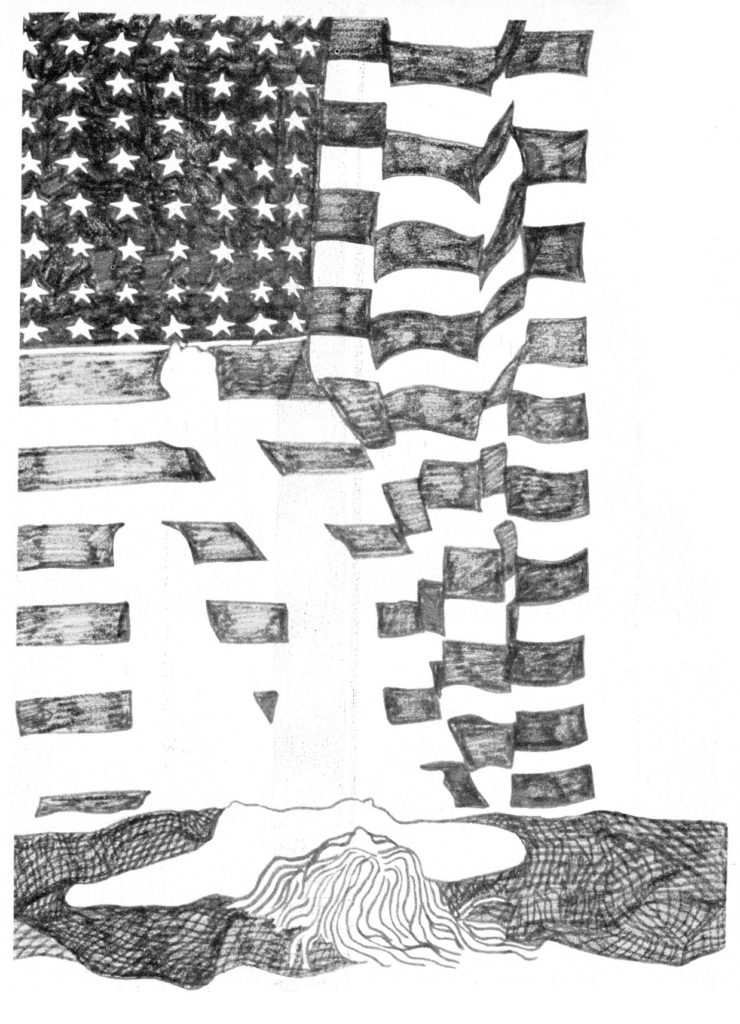 More sex from Jack Barron. Artist uncredited.
More sex from Jack Barron. Artist uncredited.
Bug Jack Barron (Part 2 of 6) by Norman Spinrad
And he’s back! Quick recap – readers may remember that Jack Barron is the media celebrity whose talk-show is widely watched across America. In the last part he took on the political world with an attack on his TV show on the Freezer Utility Bill, a law which will allow Benedict Howards and his corporation The Foundation for Human Mortality a monopoly on cryogenics in the future.
This part of the story deals with what happened after the show. Barron goes and picks up a woman for sex. Taking her back to his penthouse, they make love, but Barron spends time thinking of his ex, Sara Westerfeld.
Barron is then visited by Howards in his office. Howards is angry that Barron has appeared on television to oppose his Bill. Nevertheless, Howards offers in return for Barron’s support a free Freeze contract and therefore near-immortality. Barron refuses to take the offer, and is so annoyed that he sets up an angry tirade against Howards to be on his next show. Howards arranges a meeting with Barron’s ex-wife Sara Westerfeld to try and find a weakness in Barron’s armour. Westerfeld agrees to a contract with Howards in order to get Jack back and also bring down Howards.
So: lots of political wrangling given as long lecture-like rants, with angry cut-up phrases as prose. None of the characters come out of this particularly well, generally giving the impression that politics in America is filled with vicious characters who make their way through life by being nasty, lying and scheming. Mr. Spinrad seems to be a very angry young writer.
And as entertaining as this is, I can’t help feeling that there is little actually of any importance here. When you take away all the fripperies and the prose-stylings, there’s not a great deal of plot. I’m starting to see what others have claimed to be style over substance. 4 out of 5.
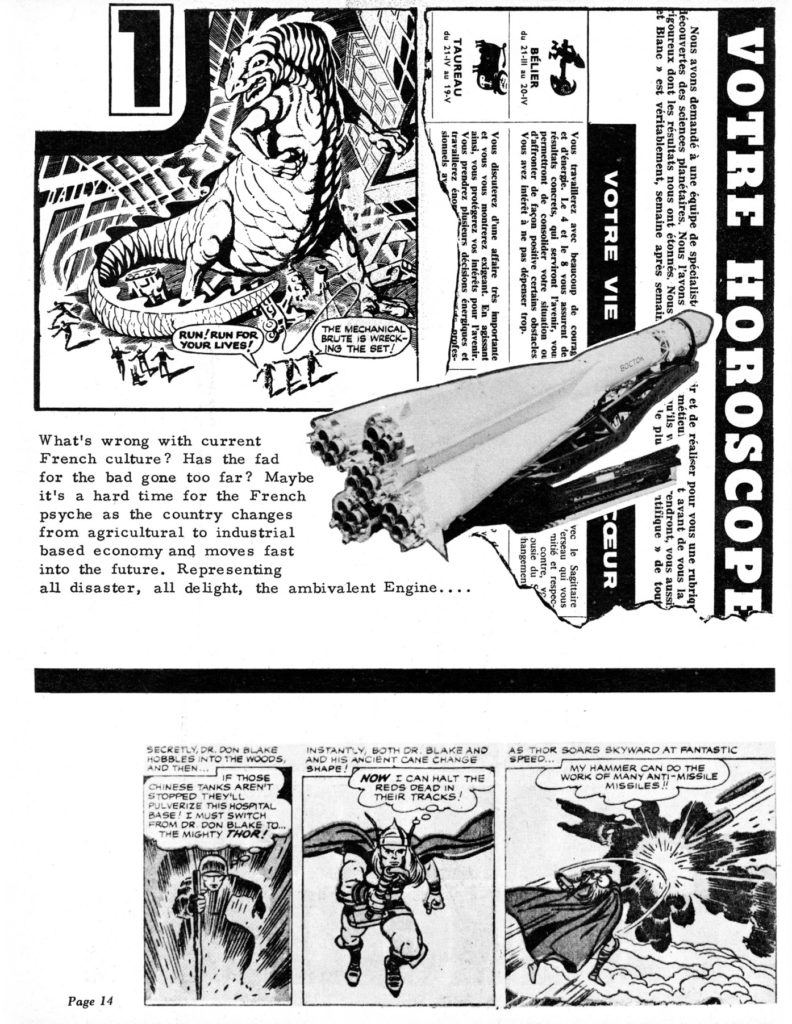 First page of the article. More cut-up stylings!
First page of the article. More cut-up stylings!
Article: Barbarella and the Anxious Frenchman by Michael Moorcock and Charles Platt
Another article written by Moorcock but filled with more of that cut-up art so beloved of current artists (and in this case by Charles Platt.) It is most definitely opinionated, a rant against the decline in standards in French SF. Why French SF? Well, (the yet-unreleased) Barbarella movie of course, which also gives a chance for Messrs Moorcock and Platt to decry that things in French SF are not as good as they used to be. Things are far too safe, too diluted, too… normal. As rants go, it’s quite fun. It’ll be interesting to see if the article gets a response or not (And where is our late, lamented Letters page?) 4 out of 5.
The Serpent of Kundalini by Brian W. Aldiss and C. C. Shackleton
After last issue’s positively odd installment, we continue with the Colin Charteris story. After seeing much of Brussels burn last month, god-like deity Colin Charteris returns to England. The story is mainly about the strange visions Charteris experiences on his return, as England has been affected by the drug bombs unleashed across Europe, though only slightly.
Whilst the descriptions are imaginative, the extract just feels like what I imagine is one long psychedelic trip and does nothing to change my view that this is still style over substance. Not quite as bad as last issue’s effort, but still relentlessly self-conscious. 3 out of 5.
The Square Root of Brain by Fritz Leiber
 Photo illustration. Does it help explain the story? Perhaps…perhaps not.
Photo illustration. Does it help explain the story? Perhaps…perhaps not.
Now here’s a name I’ve not seen around for a while, in British magazines anyway. I know that Moorcock’s a fan of Leiber’s work, so I can’t imagine much persuading was required to take up this story.
Rather clever and thoroughly scandalous, The Square Root of Brain satirizes pop culture and the insanity of modern life, juxtaposing the slight plot with dictionary quotations (!)
I did wonder if this was another example of American writers trying to “write New Wave”. It is not entirely successful – what is its point? – and yet shows that despite not being seen around much lately, Fritz has not lost any of his satirical bite. There were several places where the story just made me grin. I could see this one in a new collection of Dangerous Visions stories. 4 out of 5.
Article: Under the Sea with Hubert Humphrey by Hubert Humphrey
I must admit that at first glance I thought this title was a parody – you know, an attempt to be a riff on something like something like The Undersea World of Jacques Cousteau or Walt Disney’s Wonderful World of Color… but cynical old me, it wasn’t.
Instead, we get a political statement from the vice-president of the US dressed up as an article showing us the potential of oceanography and the need for international cooperation in future. Political angle aside, it is actually quite interesting, and shows that the seas have future potential. But it does feel a little at odds with the anti-establishment sentiment of much of the rest of the magazine. The gulf between this and Jack Barron could not be more apparent. 3 out of 5.
A Single Rose by John De Cles
 Artist: James Cawthorn
Artist: James Cawthorn
Here's another name I’ve not seen here for a while, since Sanitarium in July 1966. I liked this allegorical one (unusually for me!), a story of a man whose attempts to create perfection involve an artificially created Unicorn, and a survey to determine what makes the perfect rose, only to find in the end that it is the idea of transience that makes things special. Quite well done, if a little introspective. 3 out of 5.
In Seclusion by Harvey Jacobs
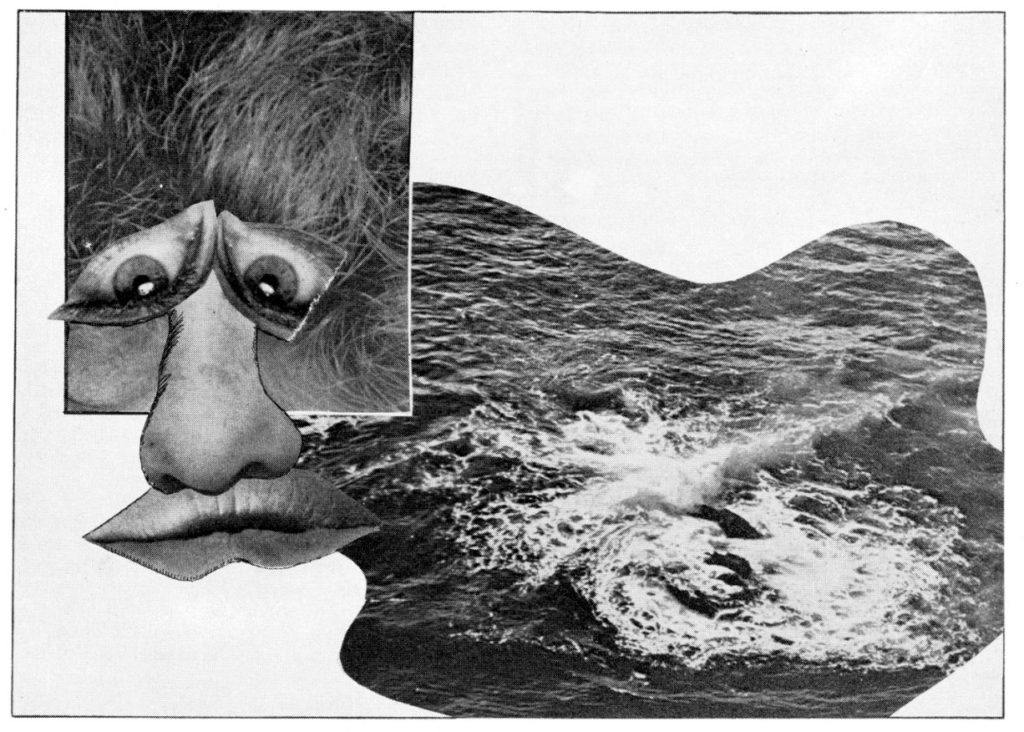 Weird art for a weird story.
Weird art for a weird story.
A story of two film stars who fall in love on-set and seeing a publicity campaign in the making are sent by their studio to a secluded abbey with no modern conveniences. The two enjoy the novelty at first but in the end they are attacked by a creature from the ocean. Lots of sexual talk and allegory, with what I assume is meant to be sparkling repartee, but in the end just feels grubby. Another example perhaps of the magazine trying to shock and show that it is more adult in nature than before. If you are engaged by talk of phalluses, seminal fluid and pubic hair you may like this one. Personally, I can’t see Elizabeth Taylor and Richard Burton doing this sort of thing. 2 out of 5.
Article: Book Review – Atrocities of the Love Slaves of Equanimity by John Sladek
This month’s Book Review seem to be another example of a writer more enamoured with their own writing than actually reviewing a book. There’s a review in there, to be honest, but it has to be deciphered from the writer’s love of his own voice. Sladek reviews Come Back, Dr. Caligari by Donald Barthelme (No, never heard of that one, either.) Despite all of the lyrical posturings, Sladek seems to quite like the book of fourteen stories, clever short stories “rich with references to Freud, high culture, pop culture, (and) existentialism.” All of which seem to fit nicely with the new New Worlds vision, even if I’m unlikely to ever think about this book again.
Summing up New Worlds
An issue that on balance I liked more than I disliked – I liked the Leiber, and thought the Moorcock & Platt article was an interesting touch – though there were elements that seemed a little overwrought. Nevertheless, it was good to have the magazine back, for all of its wayward meanderings.
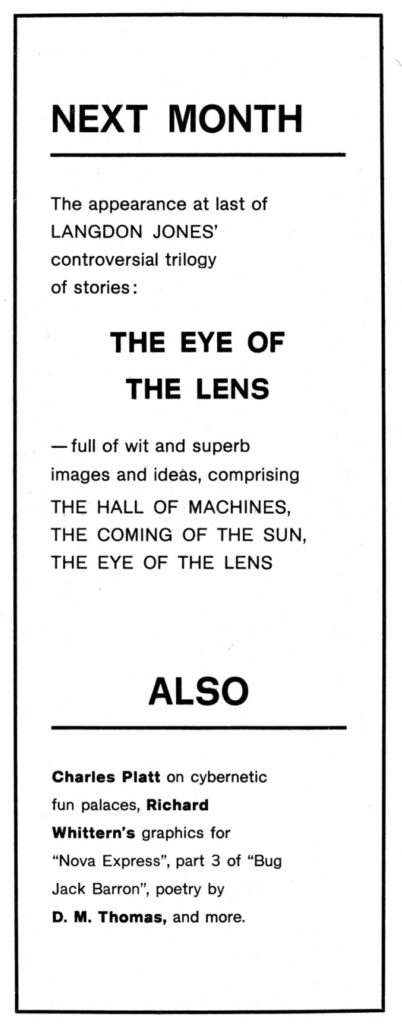
And that’s it, until next time.

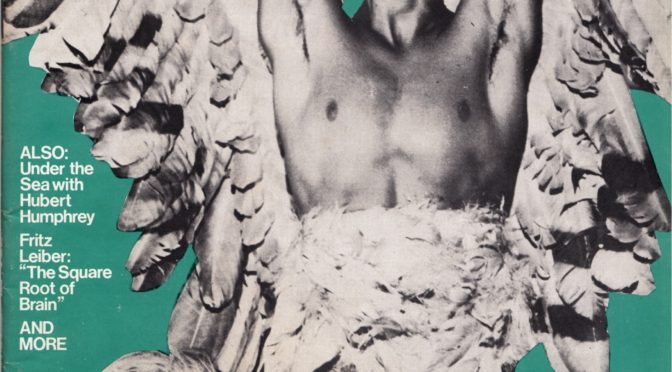

I didn't really much enjoy this one. It is possible that it is at least partially due to that middle article that felt like it was written by an older bearded gentleman in a Victorian outfit shaking his fist at the youth of today, not reading "proper literature". (Even though I know that was not the enitre intent.
As you say, Bug Jack Barron doesn't really have much happening in it other than obscenity. I suppose with the "Last Exit To Brooklyn" trial, this kind of thing still has the power to shock. However, I got a copy of that a few years back from the states and at least that was about something more.
I really hope we see the end of these Charteris stories soon. They are really dull.
Humphrey's appearance is strange. Of all the magazines to write in who would have though New Worlds would get a Vice President?
I am not convinced by what Leiber is trying to do, it kind of felt more that it was an exercise in experiment of form than meaning.
I reviewed the John de Cles last summer when it was in Famous. I basically had the same conclusions you did.
The Jacobs didn't work for me either.
Nothing much really for me then.